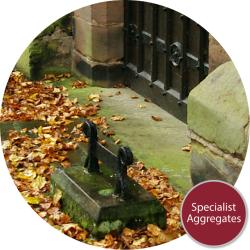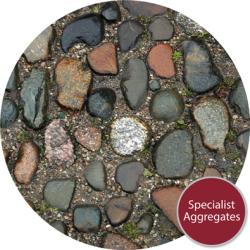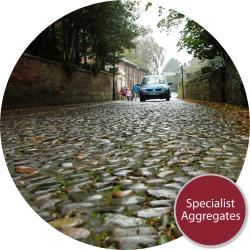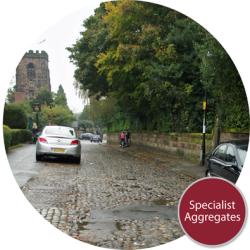|
|
|
|
|
|
 |
Individual Packs
Order and Deliver
See products for pack sizes. |
 |
Multi Packs
Order and Deliver
Convieniently packed for ease of movement. See products for pack and pallet sizes. |
 |
Bulk Bags
Order and Deliver
Selected products available bulk packed for contractors. See products for specific information. |
 |
Rockery Stone Deliveries
Order and Deliver
Caged stone delivery, packing may vary. |
 |
Order For Collection
Order for collection from a warehouse. See products for pack sizes and collection details. |
|
|
|
|
|
| Specialist Aggregates Group |


|
|
|
Specialist Aggregates investigates cobbles in the heart of Cheshire's Grappenhall village.
As the boot-scrapers beside the doorways to the 16th century St Wilfrids Church testify, at one time there must have been a lot muddy boots in Grappenhall ( 3 miles south east of Warrington, Cheshire WA4 3EP ). However, this doesn’t fit with the idyllic and, what many would claim, unique cobbled road passing the church that we see today.
With collapsing sub-base leading to an uneven surface, and botched asphalt repairs, Specialist Aggregates have been asked to advise on potential sources of cobbles for repairs and maintenance. This led us to ask, where did the cobbles come from? when were they laid? and by whom?
Substantial effort must have been expended to collect the stones and to make Church Lane the feature it is today. Whilst not being able to substantiate the claims Specialist Aggregates would like to put forward the following working hypothesis.
The cobbles are glacial in origin, the geological source being the West Coast of Scotland. Post glaciation the stones were found locally and collected together to be either “stockpiled”, perhaps as ballistic ammunition, or used for road building during the Roman Occupation sometime between the first and third century. The stones were rediscovered during the building of the Manchester Ship Canal and through local family connection were used to improve the muddy roadway beside St Wilfrid’s Church around 1890.
It is probable that the cobbles were sourced locally, however site inspection clearly demonstrates a range of granites, basalts and gritstone characteristic of the West Coast of Scotland. The geological clue is glaciation – pockets of sands and gravels can be found across North Wales and Northern England left by retreating glaciers at the end of the last Ice Age.
The cobbled road is clearly shown on photographs of the village dated 1907, however, a contemporary report of the discovery of a (cobbled) Roman Road near Wilderspool, approximately one and a half miles away in 1801 states “”were roads made of the same quality today there would be no getting from town to town now….. for the labour and expense of making them would be too great.” By inference Church Lane had not been cobbled at this point.
Wilderspool is a well documented Roman settlement with substantial evidence of working of bronze, iron, pottery and glass. It is thought that the town was a major supply hub, being well served with roads linking it to present day Middlewich, Chester, Manchester and Preston.
Some 1500 years later the Greenall family, of brewing fame, had substantial land interests in the area, not least it operated a Brewery located at Wilderspool. They owned Grappenhall Hall opposite St Wilfrid’s Church and a member of the Greenall family was rector of the church.
It is postulated that around 1890 when the Manchester Ship Canal was being dug the cobblestones were discovered in the Wilderspool area ( its also possible that the stone may have been found a little earlier during building works for the Greenall brewery ). If it were a Roman Road it would have been substantial to have yielded the volume of stones, but perhaps it may have been a munitions stockpile. Enterprising Victorians with family connections possibly put this to good use in the next village of Grappenhall.
And our claim that Church Lane, Grappenhall is one in a million?……. Perhaps we exaggerate a tad, Our best estimate is that the road contains up to ¼ million cobbles and one of them (probably a volcanic agglomerate) as our image opposite shows has been polished by traffic to reveal two hearts – now that is both verifiable and unique! The challenge is can you find it?
| Extra Information: |
|
|
For more information, please visit this related link: Granite Cobbles. |
|
|
 |
|
|
|

 About Us
About Us Delivery
Delivery Safety Information
Safety Information Terms and Conditions
Terms and Conditions Privacy Policy
Privacy Policy Press Guidelines
Press Guidelines Film Set Design
Film Set Design Bespoke Colouring
Bespoke Colouring Contract Packing
Contract Packing Research and Development
Research and Development Project Detailing
Project Detailing Public Sector Procurement
Public Sector Procurement Product Volume Guide
Product Volume Guide Product Reviews
Product Reviews Aggregate Wiki and Site Information
Aggregate Wiki and Site Information Helpdesk
Helpdesk



 Brexit Updates
Brexit Updates Product Size Guide
Product Size Guide










